Employability Skills: Considerations for Formal Meetings and Minutes
VerifiedAdded on 2023/06/16
|10
|3186
|356
Report
AI Summary
This report provides a detailed overview of employability skills in the context of formal business meetings. It begins by outlining key considerations for conducting effective formal meetings, including having a clear purpose, setting an agenda, starting and ending on time, encouraging participation, fostering a positive atmosphere, maintaining an open mind, allowing time for questions, and following up with action items. The report then discusses the importance of creative and accurate meeting minutes, emphasizing the need to record key discussions, decisions, and action items. It highlights the critical elements of well-written minutes, such as including participant names, objectives, dates, and times, as well as any amendments or voting results. Finally, the report identifies common barriers to effective meetings, such as a lack of a clear agenda, changes in priorities, late arrivals, overloaded meeting rooms, and a lack of follow-up, and suggests strategies for overcoming these challenges to ensure more productive and successful meetings. Desklib provides similar solved assignments and study resources for students.
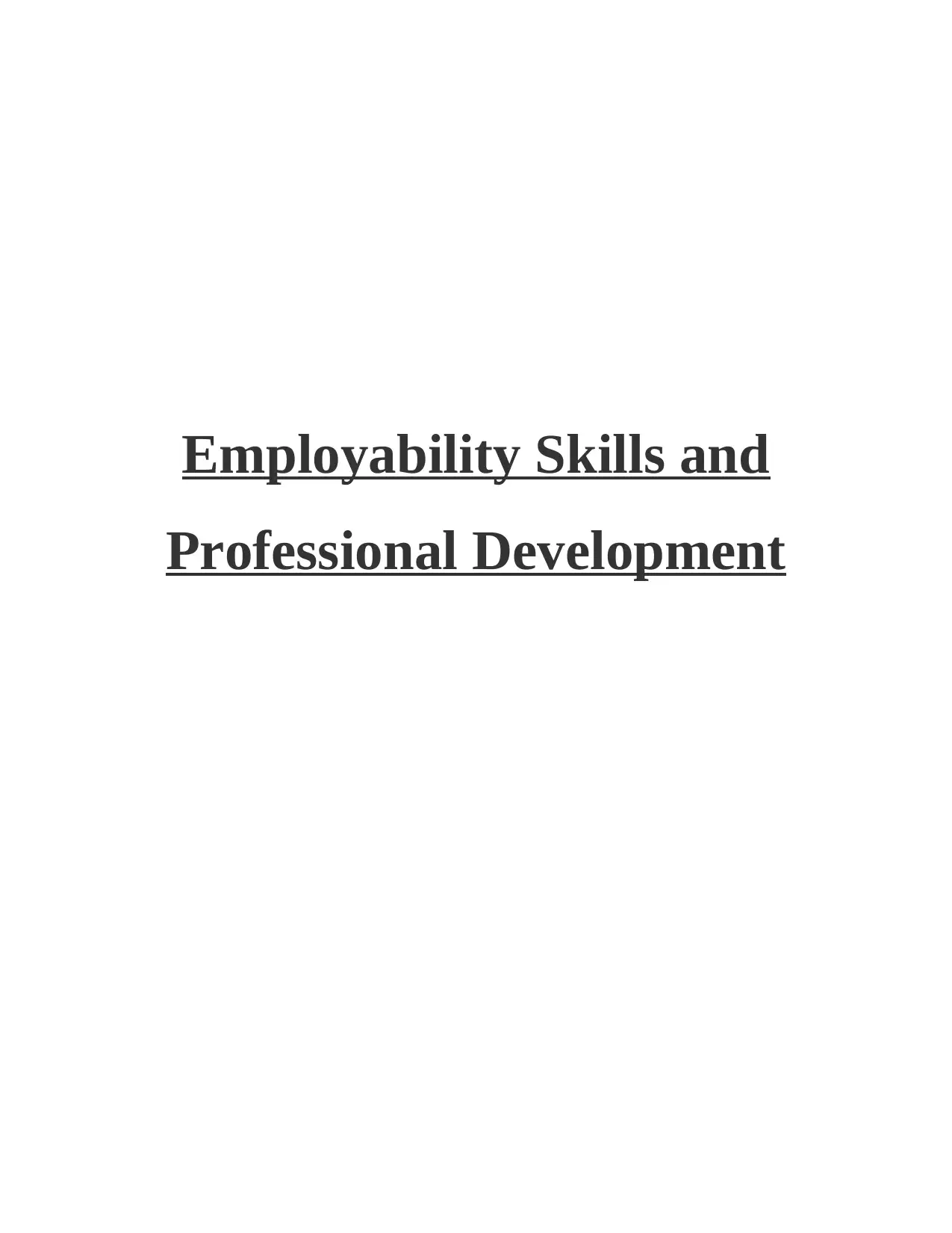
Employability Skills and
Professional Development
Professional Development
Paraphrase This Document
Need a fresh take? Get an instant paraphrase of this document with our AI Paraphraser
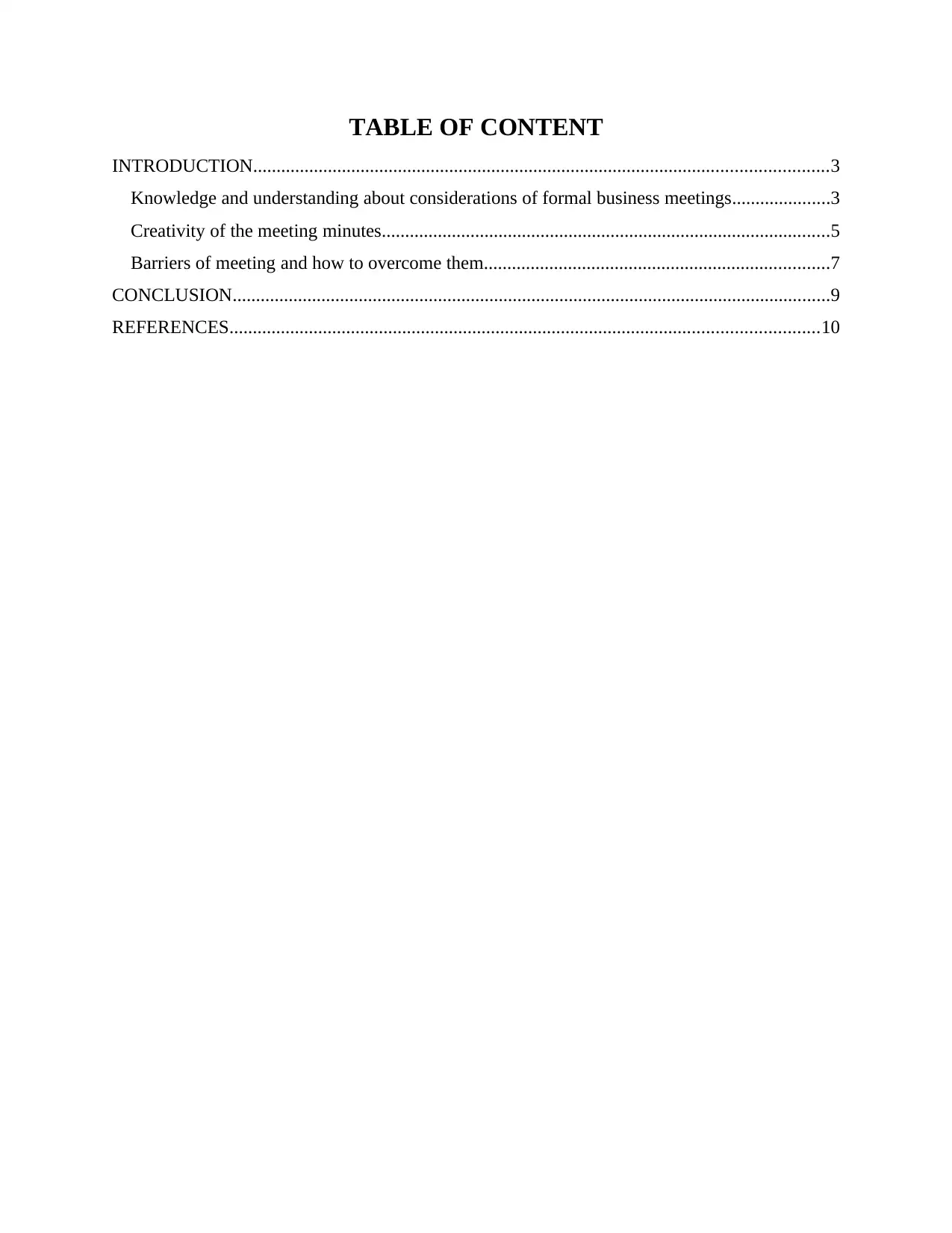
TABLE OF CONTENT
INTRODUCTION...........................................................................................................................3
Knowledge and understanding about considerations of formal business meetings.....................3
Creativity of the meeting minutes................................................................................................5
Barriers of meeting and how to overcome them..........................................................................7
CONCLUSION................................................................................................................................9
REFERENCES..............................................................................................................................10
INTRODUCTION...........................................................................................................................3
Knowledge and understanding about considerations of formal business meetings.....................3
Creativity of the meeting minutes................................................................................................5
Barriers of meeting and how to overcome them..........................................................................7
CONCLUSION................................................................................................................................9
REFERENCES..............................................................................................................................10
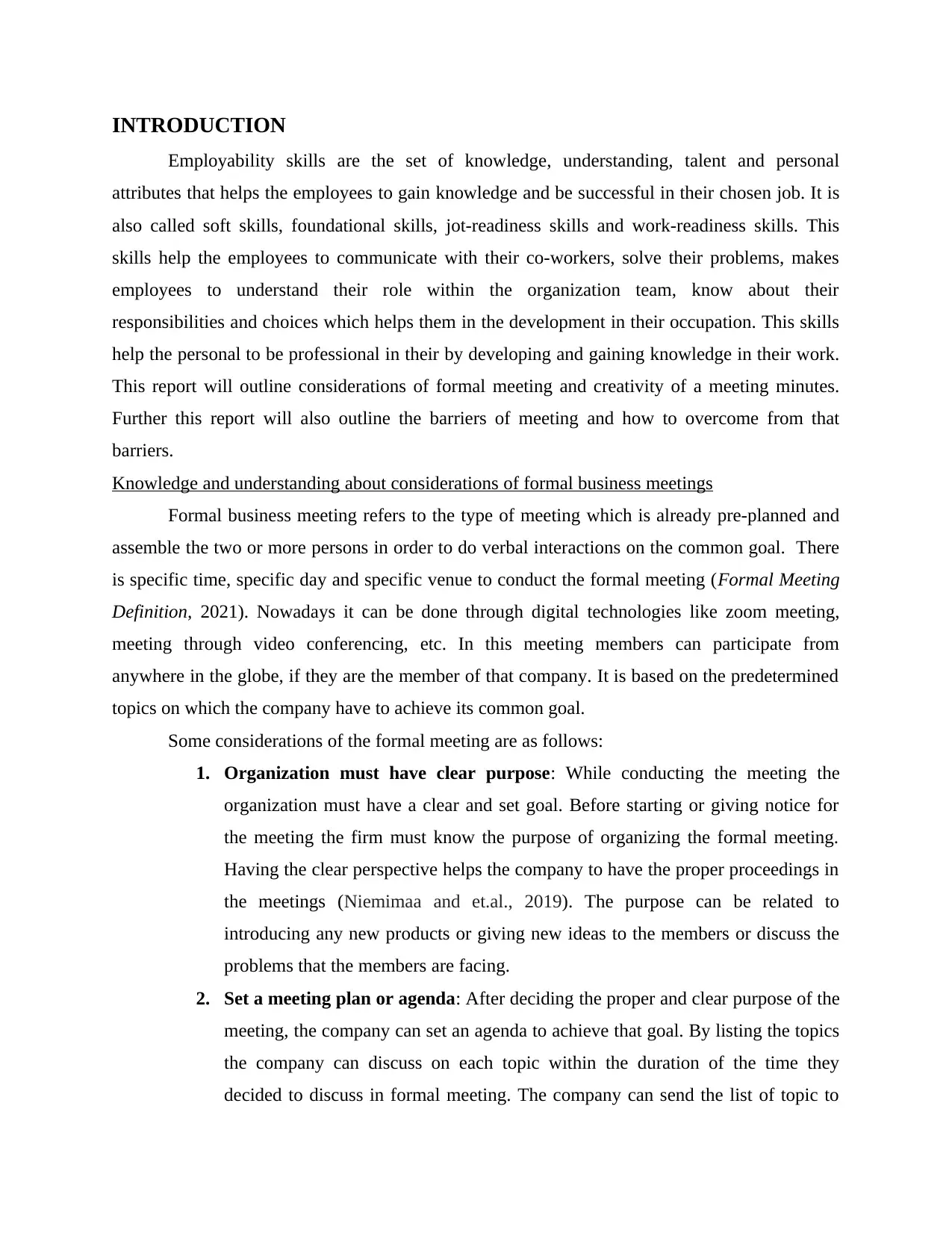
INTRODUCTION
Employability skills are the set of knowledge, understanding, talent and personal
attributes that helps the employees to gain knowledge and be successful in their chosen job. It is
also called soft skills, foundational skills, jot-readiness skills and work-readiness skills. This
skills help the employees to communicate with their co-workers, solve their problems, makes
employees to understand their role within the organization team, know about their
responsibilities and choices which helps them in the development in their occupation. This skills
help the personal to be professional in their by developing and gaining knowledge in their work.
This report will outline considerations of formal meeting and creativity of a meeting minutes.
Further this report will also outline the barriers of meeting and how to overcome from that
barriers.
Knowledge and understanding about considerations of formal business meetings
Formal business meeting refers to the type of meeting which is already pre-planned and
assemble the two or more persons in order to do verbal interactions on the common goal. There
is specific time, specific day and specific venue to conduct the formal meeting (Formal Meeting
Definition, 2021). Nowadays it can be done through digital technologies like zoom meeting,
meeting through video conferencing, etc. In this meeting members can participate from
anywhere in the globe, if they are the member of that company. It is based on the predetermined
topics on which the company have to achieve its common goal.
Some considerations of the formal meeting are as follows:
1. Organization must have clear purpose: While conducting the meeting the
organization must have a clear and set goal. Before starting or giving notice for
the meeting the firm must know the purpose of organizing the formal meeting.
Having the clear perspective helps the company to have the proper proceedings in
the meetings (Niemimaa and et.al., 2019). The purpose can be related to
introducing any new products or giving new ideas to the members or discuss the
problems that the members are facing.
2. Set a meeting plan or agenda: After deciding the proper and clear purpose of the
meeting, the company can set an agenda to achieve that goal. By listing the topics
the company can discuss on each topic within the duration of the time they
decided to discuss in formal meeting. The company can send the list of topic to
Employability skills are the set of knowledge, understanding, talent and personal
attributes that helps the employees to gain knowledge and be successful in their chosen job. It is
also called soft skills, foundational skills, jot-readiness skills and work-readiness skills. This
skills help the employees to communicate with their co-workers, solve their problems, makes
employees to understand their role within the organization team, know about their
responsibilities and choices which helps them in the development in their occupation. This skills
help the personal to be professional in their by developing and gaining knowledge in their work.
This report will outline considerations of formal meeting and creativity of a meeting minutes.
Further this report will also outline the barriers of meeting and how to overcome from that
barriers.
Knowledge and understanding about considerations of formal business meetings
Formal business meeting refers to the type of meeting which is already pre-planned and
assemble the two or more persons in order to do verbal interactions on the common goal. There
is specific time, specific day and specific venue to conduct the formal meeting (Formal Meeting
Definition, 2021). Nowadays it can be done through digital technologies like zoom meeting,
meeting through video conferencing, etc. In this meeting members can participate from
anywhere in the globe, if they are the member of that company. It is based on the predetermined
topics on which the company have to achieve its common goal.
Some considerations of the formal meeting are as follows:
1. Organization must have clear purpose: While conducting the meeting the
organization must have a clear and set goal. Before starting or giving notice for
the meeting the firm must know the purpose of organizing the formal meeting.
Having the clear perspective helps the company to have the proper proceedings in
the meetings (Niemimaa and et.al., 2019). The purpose can be related to
introducing any new products or giving new ideas to the members or discuss the
problems that the members are facing.
2. Set a meeting plan or agenda: After deciding the proper and clear purpose of the
meeting, the company can set an agenda to achieve that goal. By listing the topics
the company can discuss on each topic within the duration of the time they
decided to discuss in formal meeting. The company can send the list of topic to
⊘ This is a preview!⊘
Do you want full access?
Subscribe today to unlock all pages.

Trusted by 1+ million students worldwide
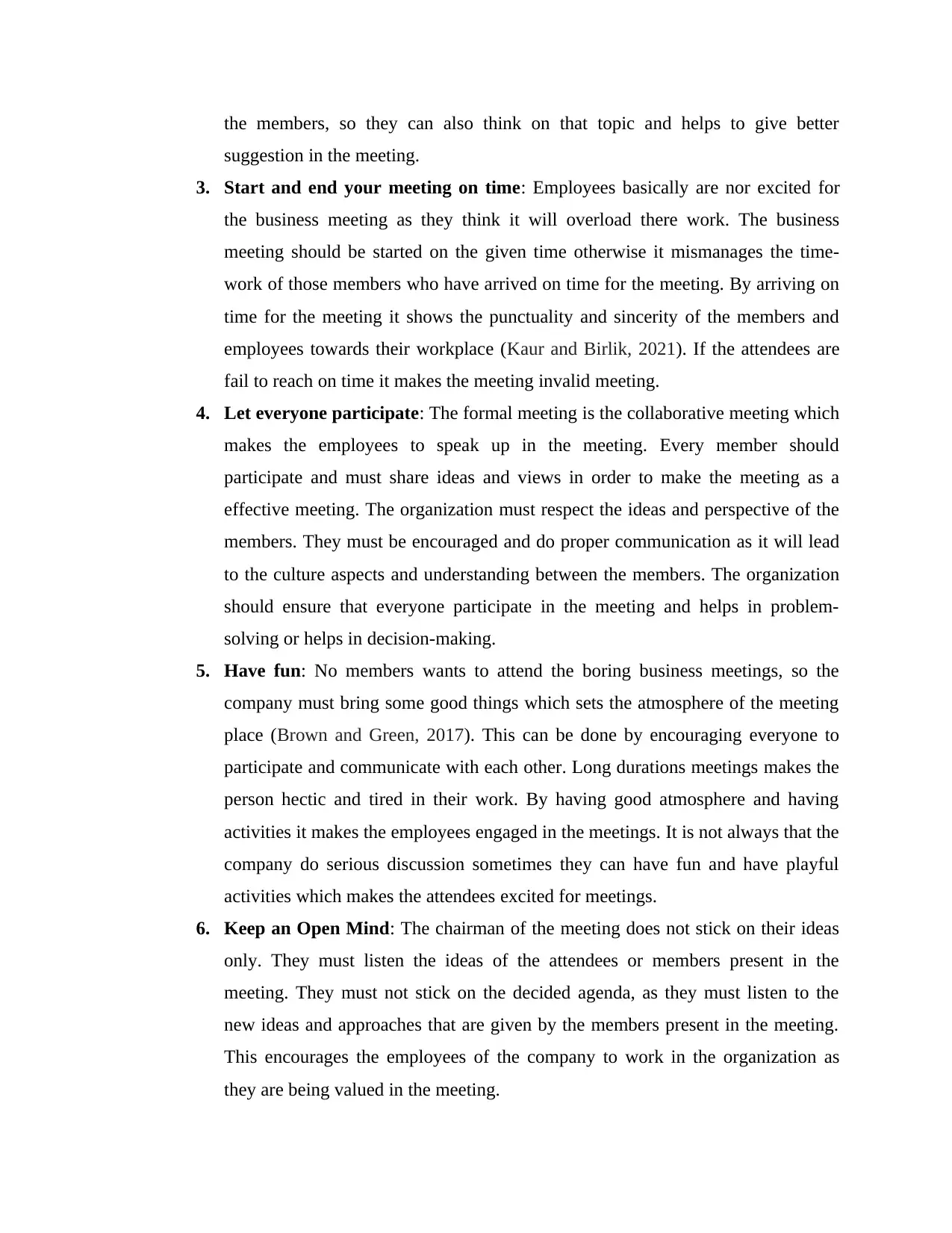
the members, so they can also think on that topic and helps to give better
suggestion in the meeting.
3. Start and end your meeting on time: Employees basically are nor excited for
the business meeting as they think it will overload there work. The business
meeting should be started on the given time otherwise it mismanages the time-
work of those members who have arrived on time for the meeting. By arriving on
time for the meeting it shows the punctuality and sincerity of the members and
employees towards their workplace (Kaur and Birlik, 2021). If the attendees are
fail to reach on time it makes the meeting invalid meeting.
4. Let everyone participate: The formal meeting is the collaborative meeting which
makes the employees to speak up in the meeting. Every member should
participate and must share ideas and views in order to make the meeting as a
effective meeting. The organization must respect the ideas and perspective of the
members. They must be encouraged and do proper communication as it will lead
to the culture aspects and understanding between the members. The organization
should ensure that everyone participate in the meeting and helps in problem-
solving or helps in decision-making.
5. Have fun: No members wants to attend the boring business meetings, so the
company must bring some good things which sets the atmosphere of the meeting
place (Brown and Green, 2017). This can be done by encouraging everyone to
participate and communicate with each other. Long durations meetings makes the
person hectic and tired in their work. By having good atmosphere and having
activities it makes the employees engaged in the meetings. It is not always that the
company do serious discussion sometimes they can have fun and have playful
activities which makes the attendees excited for meetings.
6. Keep an Open Mind: The chairman of the meeting does not stick on their ideas
only. They must listen the ideas of the attendees or members present in the
meeting. They must not stick on the decided agenda, as they must listen to the
new ideas and approaches that are given by the members present in the meeting.
This encourages the employees of the company to work in the organization as
they are being valued in the meeting.
suggestion in the meeting.
3. Start and end your meeting on time: Employees basically are nor excited for
the business meeting as they think it will overload there work. The business
meeting should be started on the given time otherwise it mismanages the time-
work of those members who have arrived on time for the meeting. By arriving on
time for the meeting it shows the punctuality and sincerity of the members and
employees towards their workplace (Kaur and Birlik, 2021). If the attendees are
fail to reach on time it makes the meeting invalid meeting.
4. Let everyone participate: The formal meeting is the collaborative meeting which
makes the employees to speak up in the meeting. Every member should
participate and must share ideas and views in order to make the meeting as a
effective meeting. The organization must respect the ideas and perspective of the
members. They must be encouraged and do proper communication as it will lead
to the culture aspects and understanding between the members. The organization
should ensure that everyone participate in the meeting and helps in problem-
solving or helps in decision-making.
5. Have fun: No members wants to attend the boring business meetings, so the
company must bring some good things which sets the atmosphere of the meeting
place (Brown and Green, 2017). This can be done by encouraging everyone to
participate and communicate with each other. Long durations meetings makes the
person hectic and tired in their work. By having good atmosphere and having
activities it makes the employees engaged in the meetings. It is not always that the
company do serious discussion sometimes they can have fun and have playful
activities which makes the attendees excited for meetings.
6. Keep an Open Mind: The chairman of the meeting does not stick on their ideas
only. They must listen the ideas of the attendees or members present in the
meeting. They must not stick on the decided agenda, as they must listen to the
new ideas and approaches that are given by the members present in the meeting.
This encourages the employees of the company to work in the organization as
they are being valued in the meeting.
Paraphrase This Document
Need a fresh take? Get an instant paraphrase of this document with our AI Paraphraser
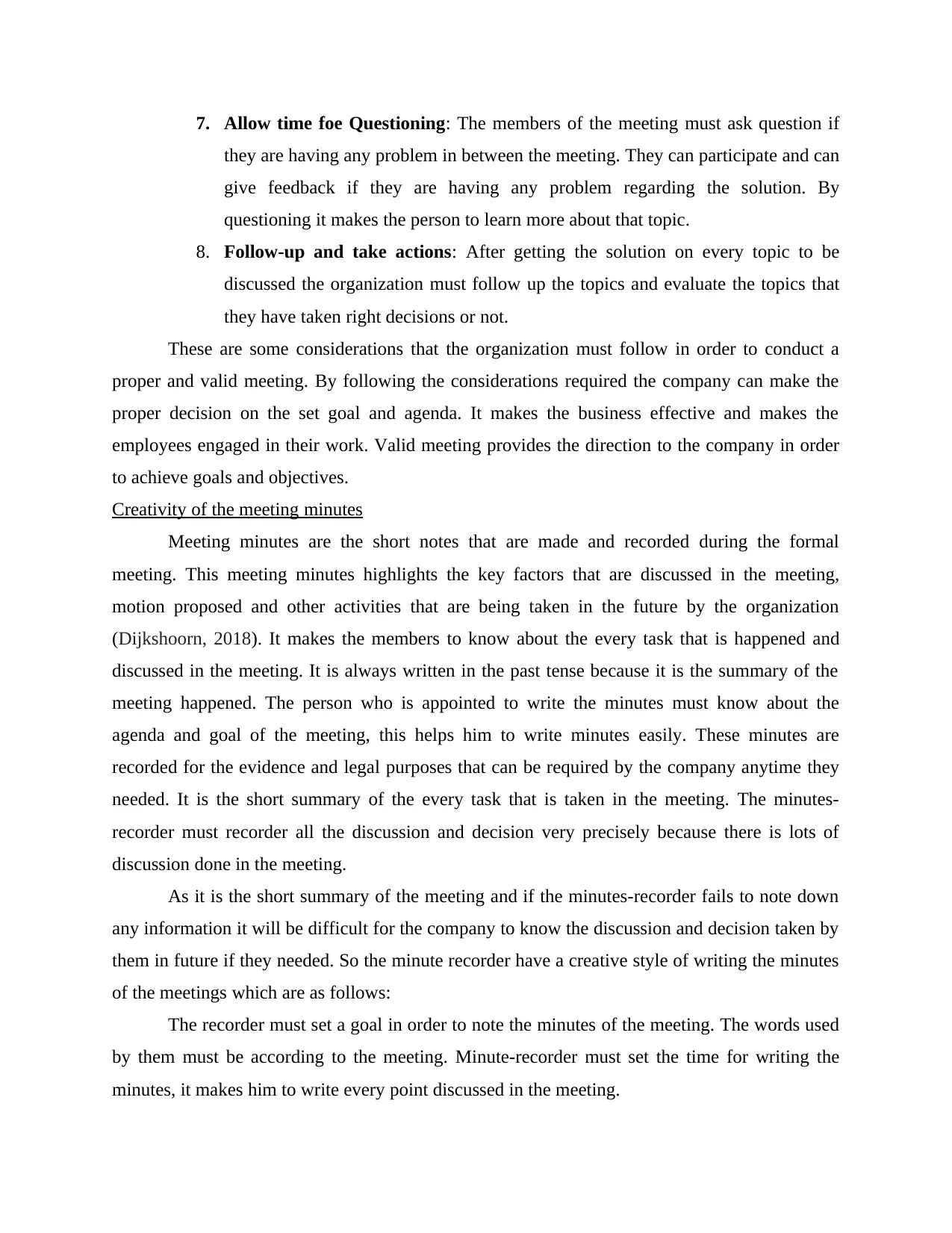
7. Allow time foe Questioning: The members of the meeting must ask question if
they are having any problem in between the meeting. They can participate and can
give feedback if they are having any problem regarding the solution. By
questioning it makes the person to learn more about that topic.
8. Follow-up and take actions: After getting the solution on every topic to be
discussed the organization must follow up the topics and evaluate the topics that
they have taken right decisions or not.
These are some considerations that the organization must follow in order to conduct a
proper and valid meeting. By following the considerations required the company can make the
proper decision on the set goal and agenda. It makes the business effective and makes the
employees engaged in their work. Valid meeting provides the direction to the company in order
to achieve goals and objectives.
Creativity of the meeting minutes
Meeting minutes are the short notes that are made and recorded during the formal
meeting. This meeting minutes highlights the key factors that are discussed in the meeting,
motion proposed and other activities that are being taken in the future by the organization
(Dijkshoorn, 2018). It makes the members to know about the every task that is happened and
discussed in the meeting. It is always written in the past tense because it is the summary of the
meeting happened. The person who is appointed to write the minutes must know about the
agenda and goal of the meeting, this helps him to write minutes easily. These minutes are
recorded for the evidence and legal purposes that can be required by the company anytime they
needed. It is the short summary of the every task that is taken in the meeting. The minutes-
recorder must recorder all the discussion and decision very precisely because there is lots of
discussion done in the meeting.
As it is the short summary of the meeting and if the minutes-recorder fails to note down
any information it will be difficult for the company to know the discussion and decision taken by
them in future if they needed. So the minute recorder have a creative style of writing the minutes
of the meetings which are as follows:
The recorder must set a goal in order to note the minutes of the meeting. The words used
by them must be according to the meeting. Minute-recorder must set the time for writing the
minutes, it makes him to write every point discussed in the meeting.
they are having any problem in between the meeting. They can participate and can
give feedback if they are having any problem regarding the solution. By
questioning it makes the person to learn more about that topic.
8. Follow-up and take actions: After getting the solution on every topic to be
discussed the organization must follow up the topics and evaluate the topics that
they have taken right decisions or not.
These are some considerations that the organization must follow in order to conduct a
proper and valid meeting. By following the considerations required the company can make the
proper decision on the set goal and agenda. It makes the business effective and makes the
employees engaged in their work. Valid meeting provides the direction to the company in order
to achieve goals and objectives.
Creativity of the meeting minutes
Meeting minutes are the short notes that are made and recorded during the formal
meeting. This meeting minutes highlights the key factors that are discussed in the meeting,
motion proposed and other activities that are being taken in the future by the organization
(Dijkshoorn, 2018). It makes the members to know about the every task that is happened and
discussed in the meeting. It is always written in the past tense because it is the summary of the
meeting happened. The person who is appointed to write the minutes must know about the
agenda and goal of the meeting, this helps him to write minutes easily. These minutes are
recorded for the evidence and legal purposes that can be required by the company anytime they
needed. It is the short summary of the every task that is taken in the meeting. The minutes-
recorder must recorder all the discussion and decision very precisely because there is lots of
discussion done in the meeting.
As it is the short summary of the meeting and if the minutes-recorder fails to note down
any information it will be difficult for the company to know the discussion and decision taken by
them in future if they needed. So the minute recorder have a creative style of writing the minutes
of the meetings which are as follows:
The recorder must set a goal in order to note the minutes of the meeting. The words used
by them must be according to the meeting. Minute-recorder must set the time for writing the
minutes, it makes him to write every point discussed in the meeting.
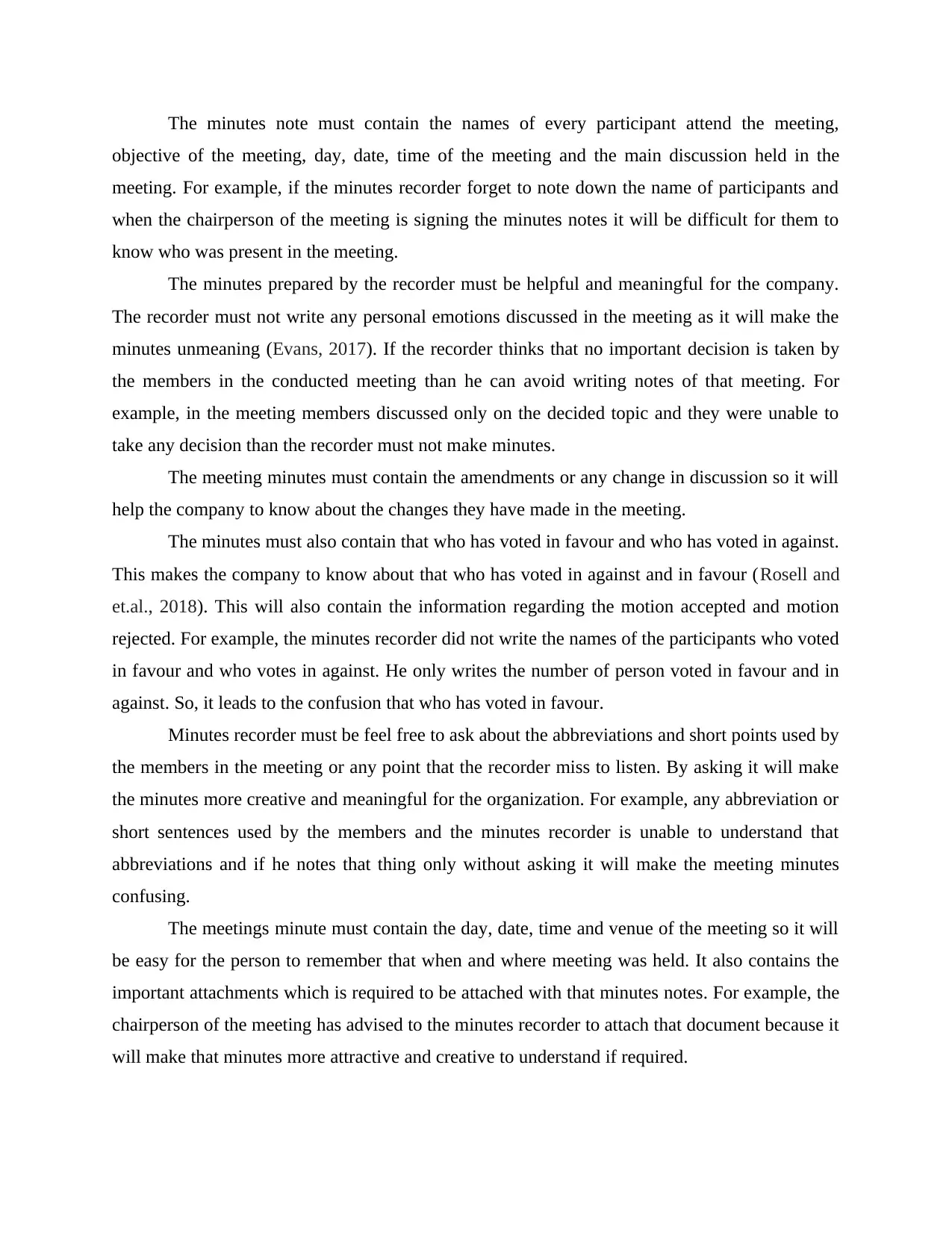
The minutes note must contain the names of every participant attend the meeting,
objective of the meeting, day, date, time of the meeting and the main discussion held in the
meeting. For example, if the minutes recorder forget to note down the name of participants and
when the chairperson of the meeting is signing the minutes notes it will be difficult for them to
know who was present in the meeting.
The minutes prepared by the recorder must be helpful and meaningful for the company.
The recorder must not write any personal emotions discussed in the meeting as it will make the
minutes unmeaning (Evans, 2017). If the recorder thinks that no important decision is taken by
the members in the conducted meeting than he can avoid writing notes of that meeting. For
example, in the meeting members discussed only on the decided topic and they were unable to
take any decision than the recorder must not make minutes.
The meeting minutes must contain the amendments or any change in discussion so it will
help the company to know about the changes they have made in the meeting.
The minutes must also contain that who has voted in favour and who has voted in against.
This makes the company to know about that who has voted in against and in favour (Rosell and
et.al., 2018). This will also contain the information regarding the motion accepted and motion
rejected. For example, the minutes recorder did not write the names of the participants who voted
in favour and who votes in against. He only writes the number of person voted in favour and in
against. So, it leads to the confusion that who has voted in favour.
Minutes recorder must be feel free to ask about the abbreviations and short points used by
the members in the meeting or any point that the recorder miss to listen. By asking it will make
the minutes more creative and meaningful for the organization. For example, any abbreviation or
short sentences used by the members and the minutes recorder is unable to understand that
abbreviations and if he notes that thing only without asking it will make the meeting minutes
confusing.
The meetings minute must contain the day, date, time and venue of the meeting so it will
be easy for the person to remember that when and where meeting was held. It also contains the
important attachments which is required to be attached with that minutes notes. For example, the
chairperson of the meeting has advised to the minutes recorder to attach that document because it
will make that minutes more attractive and creative to understand if required.
objective of the meeting, day, date, time of the meeting and the main discussion held in the
meeting. For example, if the minutes recorder forget to note down the name of participants and
when the chairperson of the meeting is signing the minutes notes it will be difficult for them to
know who was present in the meeting.
The minutes prepared by the recorder must be helpful and meaningful for the company.
The recorder must not write any personal emotions discussed in the meeting as it will make the
minutes unmeaning (Evans, 2017). If the recorder thinks that no important decision is taken by
the members in the conducted meeting than he can avoid writing notes of that meeting. For
example, in the meeting members discussed only on the decided topic and they were unable to
take any decision than the recorder must not make minutes.
The meeting minutes must contain the amendments or any change in discussion so it will
help the company to know about the changes they have made in the meeting.
The minutes must also contain that who has voted in favour and who has voted in against.
This makes the company to know about that who has voted in against and in favour (Rosell and
et.al., 2018). This will also contain the information regarding the motion accepted and motion
rejected. For example, the minutes recorder did not write the names of the participants who voted
in favour and who votes in against. He only writes the number of person voted in favour and in
against. So, it leads to the confusion that who has voted in favour.
Minutes recorder must be feel free to ask about the abbreviations and short points used by
the members in the meeting or any point that the recorder miss to listen. By asking it will make
the minutes more creative and meaningful for the organization. For example, any abbreviation or
short sentences used by the members and the minutes recorder is unable to understand that
abbreviations and if he notes that thing only without asking it will make the meeting minutes
confusing.
The meetings minute must contain the day, date, time and venue of the meeting so it will
be easy for the person to remember that when and where meeting was held. It also contains the
important attachments which is required to be attached with that minutes notes. For example, the
chairperson of the meeting has advised to the minutes recorder to attach that document because it
will make that minutes more attractive and creative to understand if required.
⊘ This is a preview!⊘
Do you want full access?
Subscribe today to unlock all pages.

Trusted by 1+ million students worldwide
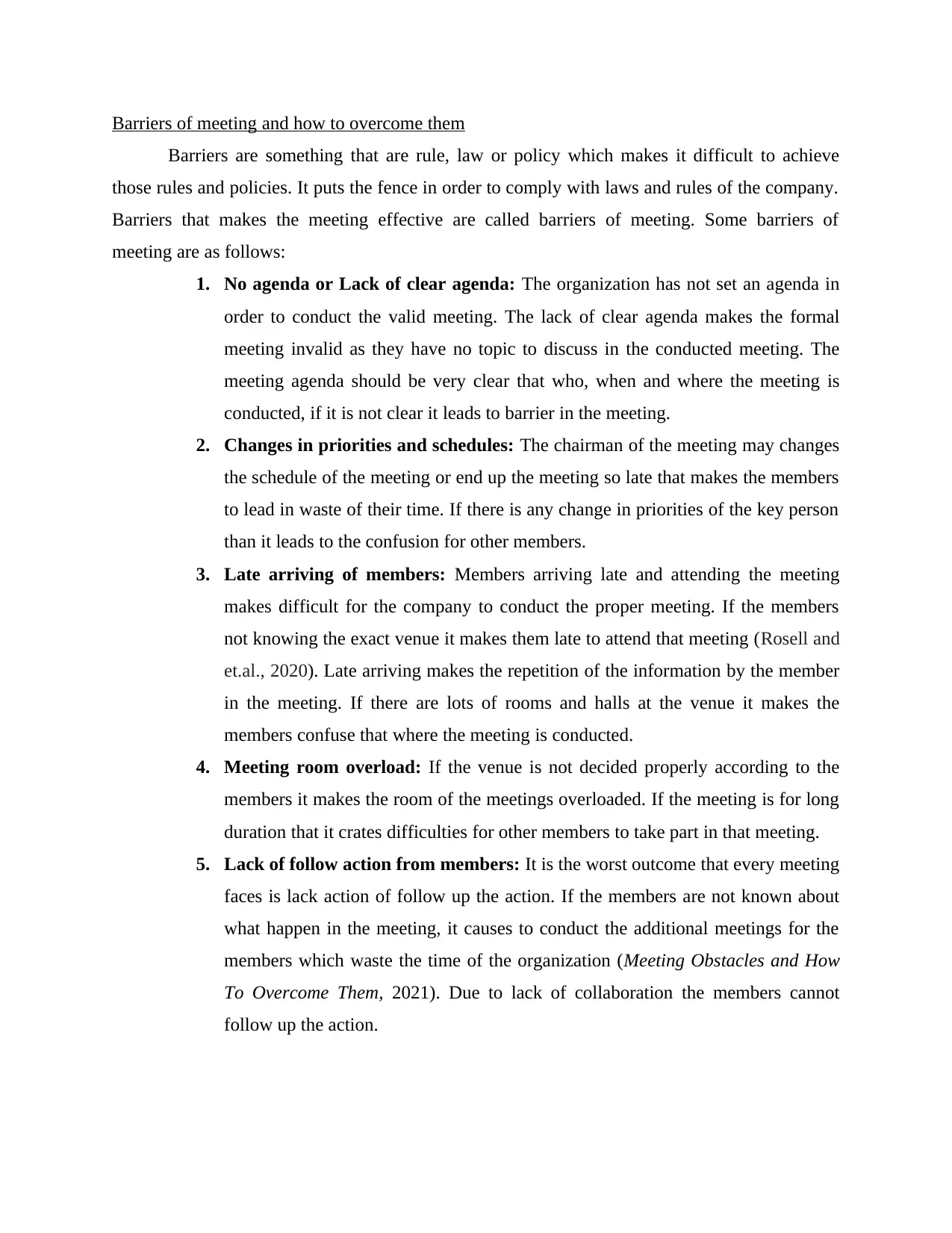
Barriers of meeting and how to overcome them
Barriers are something that are rule, law or policy which makes it difficult to achieve
those rules and policies. It puts the fence in order to comply with laws and rules of the company.
Barriers that makes the meeting effective are called barriers of meeting. Some barriers of
meeting are as follows:
1. No agenda or Lack of clear agenda: The organization has not set an agenda in
order to conduct the valid meeting. The lack of clear agenda makes the formal
meeting invalid as they have no topic to discuss in the conducted meeting. The
meeting agenda should be very clear that who, when and where the meeting is
conducted, if it is not clear it leads to barrier in the meeting.
2. Changes in priorities and schedules: The chairman of the meeting may changes
the schedule of the meeting or end up the meeting so late that makes the members
to lead in waste of their time. If there is any change in priorities of the key person
than it leads to the confusion for other members.
3. Late arriving of members: Members arriving late and attending the meeting
makes difficult for the company to conduct the proper meeting. If the members
not knowing the exact venue it makes them late to attend that meeting (Rosell and
et.al., 2020). Late arriving makes the repetition of the information by the member
in the meeting. If there are lots of rooms and halls at the venue it makes the
members confuse that where the meeting is conducted.
4. Meeting room overload: If the venue is not decided properly according to the
members it makes the room of the meetings overloaded. If the meeting is for long
duration that it crates difficulties for other members to take part in that meeting.
5. Lack of follow action from members: It is the worst outcome that every meeting
faces is lack action of follow up the action. If the members are not known about
what happen in the meeting, it causes to conduct the additional meetings for the
members which waste the time of the organization (Meeting Obstacles and How
To Overcome Them, 2021). Due to lack of collaboration the members cannot
follow up the action.
Barriers are something that are rule, law or policy which makes it difficult to achieve
those rules and policies. It puts the fence in order to comply with laws and rules of the company.
Barriers that makes the meeting effective are called barriers of meeting. Some barriers of
meeting are as follows:
1. No agenda or Lack of clear agenda: The organization has not set an agenda in
order to conduct the valid meeting. The lack of clear agenda makes the formal
meeting invalid as they have no topic to discuss in the conducted meeting. The
meeting agenda should be very clear that who, when and where the meeting is
conducted, if it is not clear it leads to barrier in the meeting.
2. Changes in priorities and schedules: The chairman of the meeting may changes
the schedule of the meeting or end up the meeting so late that makes the members
to lead in waste of their time. If there is any change in priorities of the key person
than it leads to the confusion for other members.
3. Late arriving of members: Members arriving late and attending the meeting
makes difficult for the company to conduct the proper meeting. If the members
not knowing the exact venue it makes them late to attend that meeting (Rosell and
et.al., 2020). Late arriving makes the repetition of the information by the member
in the meeting. If there are lots of rooms and halls at the venue it makes the
members confuse that where the meeting is conducted.
4. Meeting room overload: If the venue is not decided properly according to the
members it makes the room of the meetings overloaded. If the meeting is for long
duration that it crates difficulties for other members to take part in that meeting.
5. Lack of follow action from members: It is the worst outcome that every meeting
faces is lack action of follow up the action. If the members are not known about
what happen in the meeting, it causes to conduct the additional meetings for the
members which waste the time of the organization (Meeting Obstacles and How
To Overcome Them, 2021). Due to lack of collaboration the members cannot
follow up the action.
Paraphrase This Document
Need a fresh take? Get an instant paraphrase of this document with our AI Paraphraser
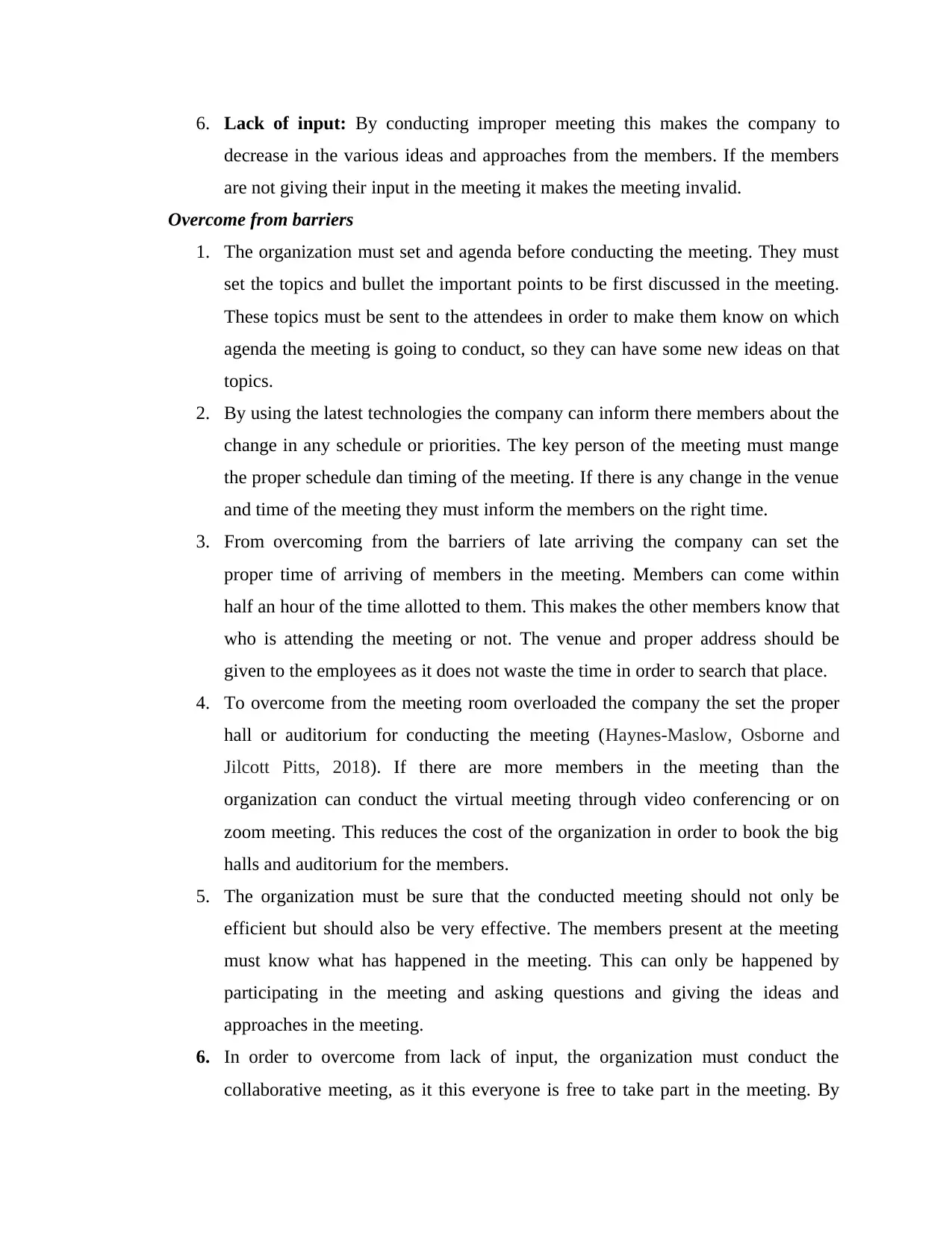
6. Lack of input: By conducting improper meeting this makes the company to
decrease in the various ideas and approaches from the members. If the members
are not giving their input in the meeting it makes the meeting invalid.
Overcome from barriers
1. The organization must set and agenda before conducting the meeting. They must
set the topics and bullet the important points to be first discussed in the meeting.
These topics must be sent to the attendees in order to make them know on which
agenda the meeting is going to conduct, so they can have some new ideas on that
topics.
2. By using the latest technologies the company can inform there members about the
change in any schedule or priorities. The key person of the meeting must mange
the proper schedule dan timing of the meeting. If there is any change in the venue
and time of the meeting they must inform the members on the right time.
3. From overcoming from the barriers of late arriving the company can set the
proper time of arriving of members in the meeting. Members can come within
half an hour of the time allotted to them. This makes the other members know that
who is attending the meeting or not. The venue and proper address should be
given to the employees as it does not waste the time in order to search that place.
4. To overcome from the meeting room overloaded the company the set the proper
hall or auditorium for conducting the meeting (Haynes-Maslow, Osborne and
Jilcott Pitts, 2018). If there are more members in the meeting than the
organization can conduct the virtual meeting through video conferencing or on
zoom meeting. This reduces the cost of the organization in order to book the big
halls and auditorium for the members.
5. The organization must be sure that the conducted meeting should not only be
efficient but should also be very effective. The members present at the meeting
must know what has happened in the meeting. This can only be happened by
participating in the meeting and asking questions and giving the ideas and
approaches in the meeting.
6. In order to overcome from lack of input, the organization must conduct the
collaborative meeting, as it this everyone is free to take part in the meeting. By
decrease in the various ideas and approaches from the members. If the members
are not giving their input in the meeting it makes the meeting invalid.
Overcome from barriers
1. The organization must set and agenda before conducting the meeting. They must
set the topics and bullet the important points to be first discussed in the meeting.
These topics must be sent to the attendees in order to make them know on which
agenda the meeting is going to conduct, so they can have some new ideas on that
topics.
2. By using the latest technologies the company can inform there members about the
change in any schedule or priorities. The key person of the meeting must mange
the proper schedule dan timing of the meeting. If there is any change in the venue
and time of the meeting they must inform the members on the right time.
3. From overcoming from the barriers of late arriving the company can set the
proper time of arriving of members in the meeting. Members can come within
half an hour of the time allotted to them. This makes the other members know that
who is attending the meeting or not. The venue and proper address should be
given to the employees as it does not waste the time in order to search that place.
4. To overcome from the meeting room overloaded the company the set the proper
hall or auditorium for conducting the meeting (Haynes-Maslow, Osborne and
Jilcott Pitts, 2018). If there are more members in the meeting than the
organization can conduct the virtual meeting through video conferencing or on
zoom meeting. This reduces the cost of the organization in order to book the big
halls and auditorium for the members.
5. The organization must be sure that the conducted meeting should not only be
efficient but should also be very effective. The members present at the meeting
must know what has happened in the meeting. This can only be happened by
participating in the meeting and asking questions and giving the ideas and
approaches in the meeting.
6. In order to overcome from lack of input, the organization must conduct the
collaborative meeting, as it this everyone is free to take part in the meeting. By
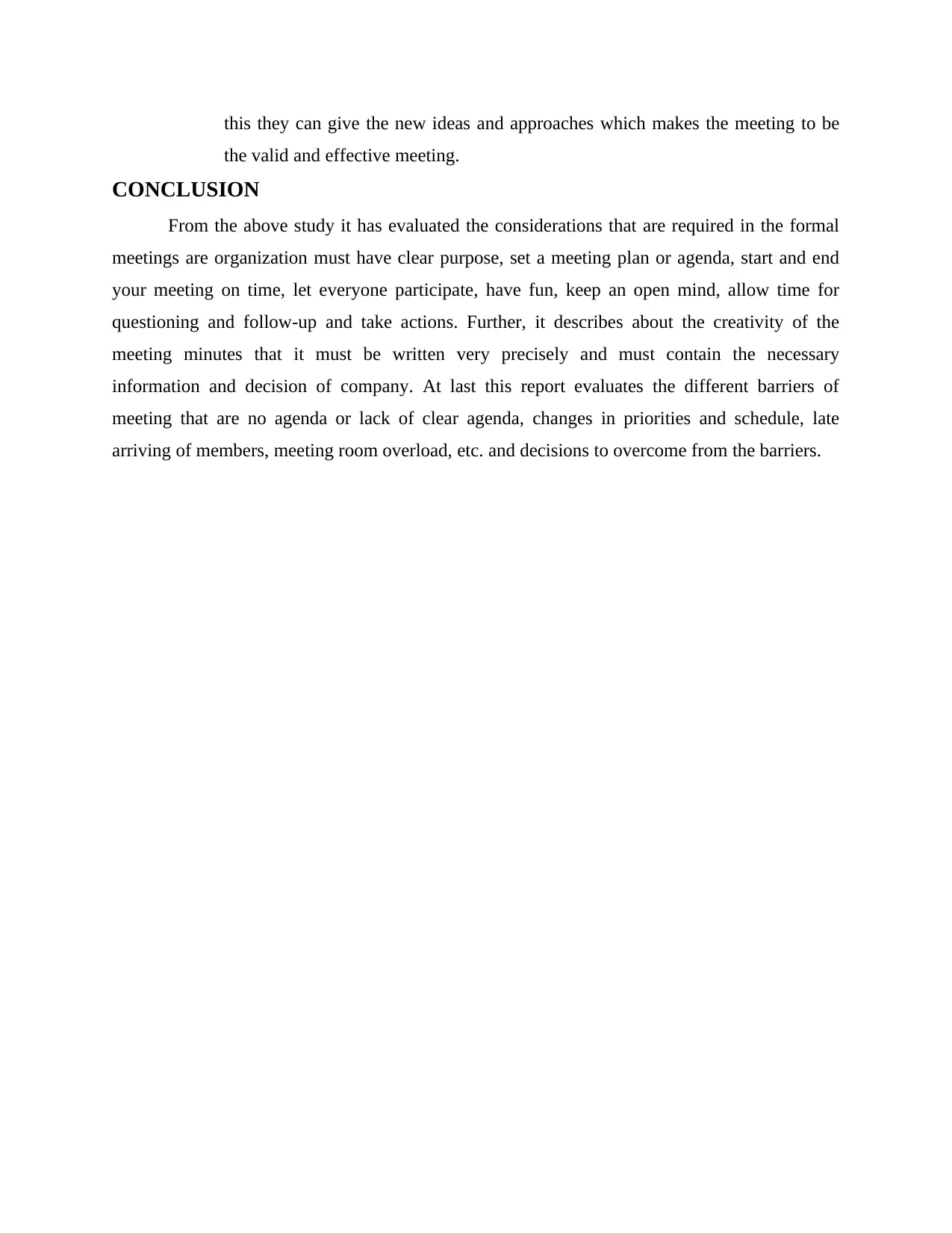
this they can give the new ideas and approaches which makes the meeting to be
the valid and effective meeting.
CONCLUSION
From the above study it has evaluated the considerations that are required in the formal
meetings are organization must have clear purpose, set a meeting plan or agenda, start and end
your meeting on time, let everyone participate, have fun, keep an open mind, allow time for
questioning and follow-up and take actions. Further, it describes about the creativity of the
meeting minutes that it must be written very precisely and must contain the necessary
information and decision of company. At last this report evaluates the different barriers of
meeting that are no agenda or lack of clear agenda, changes in priorities and schedule, late
arriving of members, meeting room overload, etc. and decisions to overcome from the barriers.
the valid and effective meeting.
CONCLUSION
From the above study it has evaluated the considerations that are required in the formal
meetings are organization must have clear purpose, set a meeting plan or agenda, start and end
your meeting on time, let everyone participate, have fun, keep an open mind, allow time for
questioning and follow-up and take actions. Further, it describes about the creativity of the
meeting minutes that it must be written very precisely and must contain the necessary
information and decision of company. At last this report evaluates the different barriers of
meeting that are no agenda or lack of clear agenda, changes in priorities and schedule, late
arriving of members, meeting room overload, etc. and decisions to overcome from the barriers.
⊘ This is a preview!⊘
Do you want full access?
Subscribe today to unlock all pages.

Trusted by 1+ million students worldwide
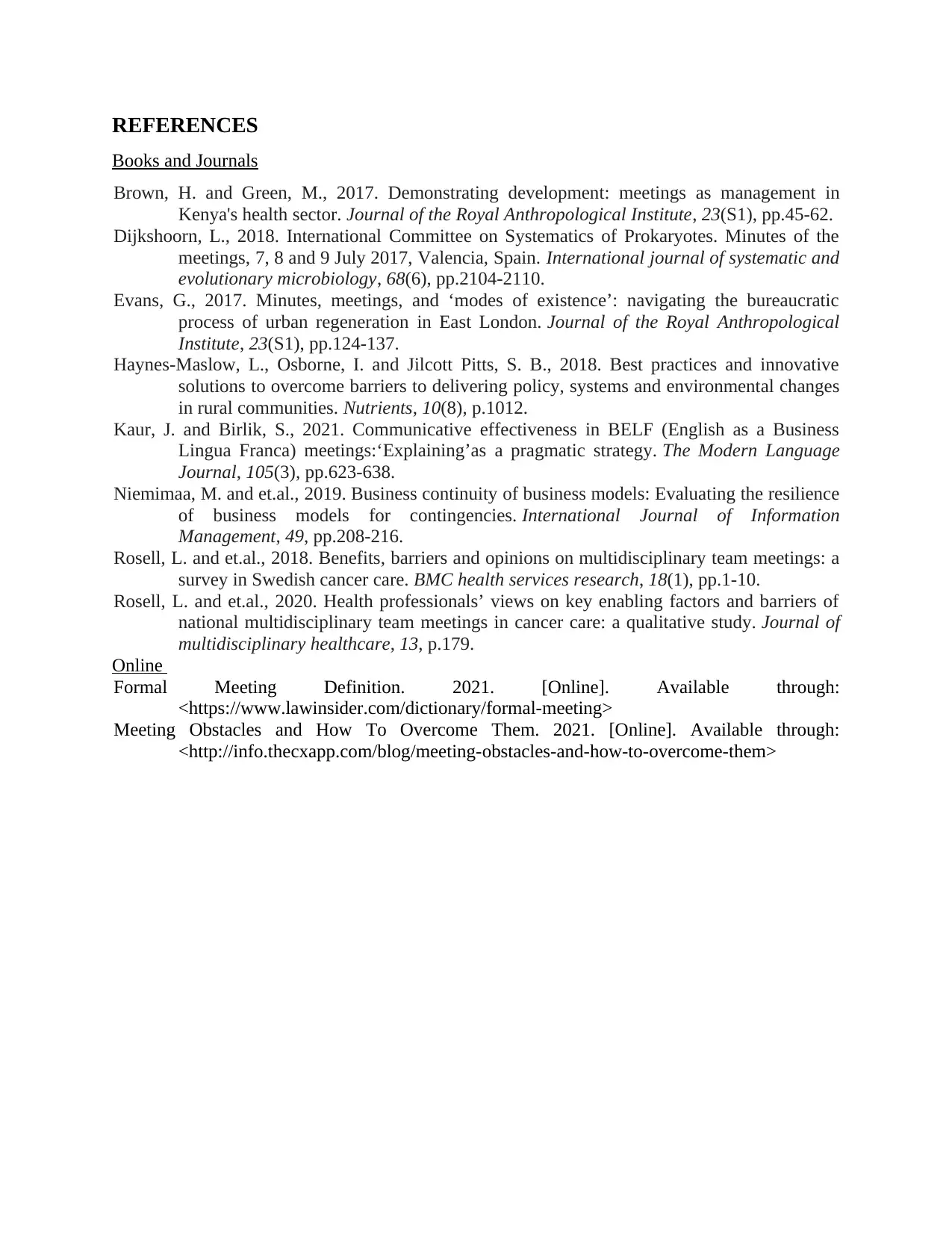
REFERENCES
Books and Journals
Brown, H. and Green, M., 2017. Demonstrating development: meetings as management in
Kenya's health sector. Journal of the Royal Anthropological Institute, 23(S1), pp.45-62.
Dijkshoorn, L., 2018. International Committee on Systematics of Prokaryotes. Minutes of the
meetings, 7, 8 and 9 July 2017, Valencia, Spain. International journal of systematic and
evolutionary microbiology, 68(6), pp.2104-2110.
Evans, G., 2017. Minutes, meetings, and ‘modes of existence’: navigating the bureaucratic
process of urban regeneration in East London. Journal of the Royal Anthropological
Institute, 23(S1), pp.124-137.
Haynes-Maslow, L., Osborne, I. and Jilcott Pitts, S. B., 2018. Best practices and innovative
solutions to overcome barriers to delivering policy, systems and environmental changes
in rural communities. Nutrients, 10(8), p.1012.
Kaur, J. and Birlik, S., 2021. Communicative effectiveness in BELF (English as a Business
Lingua Franca) meetings:‘Explaining’as a pragmatic strategy. The Modern Language
Journal, 105(3), pp.623-638.
Niemimaa, M. and et.al., 2019. Business continuity of business models: Evaluating the resilience
of business models for contingencies. International Journal of Information
Management, 49, pp.208-216.
Rosell, L. and et.al., 2018. Benefits, barriers and opinions on multidisciplinary team meetings: a
survey in Swedish cancer care. BMC health services research, 18(1), pp.1-10.
Rosell, L. and et.al., 2020. Health professionals’ views on key enabling factors and barriers of
national multidisciplinary team meetings in cancer care: a qualitative study. Journal of
multidisciplinary healthcare, 13, p.179.
Online
Formal Meeting Definition. 2021. [Online]. Available through:
<https://www.lawinsider.com/dictionary/formal-meeting>
Meeting Obstacles and How To Overcome Them. 2021. [Online]. Available through:
<http://info.thecxapp.com/blog/meeting-obstacles-and-how-to-overcome-them>
Books and Journals
Brown, H. and Green, M., 2017. Demonstrating development: meetings as management in
Kenya's health sector. Journal of the Royal Anthropological Institute, 23(S1), pp.45-62.
Dijkshoorn, L., 2018. International Committee on Systematics of Prokaryotes. Minutes of the
meetings, 7, 8 and 9 July 2017, Valencia, Spain. International journal of systematic and
evolutionary microbiology, 68(6), pp.2104-2110.
Evans, G., 2017. Minutes, meetings, and ‘modes of existence’: navigating the bureaucratic
process of urban regeneration in East London. Journal of the Royal Anthropological
Institute, 23(S1), pp.124-137.
Haynes-Maslow, L., Osborne, I. and Jilcott Pitts, S. B., 2018. Best practices and innovative
solutions to overcome barriers to delivering policy, systems and environmental changes
in rural communities. Nutrients, 10(8), p.1012.
Kaur, J. and Birlik, S., 2021. Communicative effectiveness in BELF (English as a Business
Lingua Franca) meetings:‘Explaining’as a pragmatic strategy. The Modern Language
Journal, 105(3), pp.623-638.
Niemimaa, M. and et.al., 2019. Business continuity of business models: Evaluating the resilience
of business models for contingencies. International Journal of Information
Management, 49, pp.208-216.
Rosell, L. and et.al., 2018. Benefits, barriers and opinions on multidisciplinary team meetings: a
survey in Swedish cancer care. BMC health services research, 18(1), pp.1-10.
Rosell, L. and et.al., 2020. Health professionals’ views on key enabling factors and barriers of
national multidisciplinary team meetings in cancer care: a qualitative study. Journal of
multidisciplinary healthcare, 13, p.179.
Online
Formal Meeting Definition. 2021. [Online]. Available through:
<https://www.lawinsider.com/dictionary/formal-meeting>
Meeting Obstacles and How To Overcome Them. 2021. [Online]. Available through:
<http://info.thecxapp.com/blog/meeting-obstacles-and-how-to-overcome-them>
1 out of 10
Related Documents
Your All-in-One AI-Powered Toolkit for Academic Success.
+13062052269
info@desklib.com
Available 24*7 on WhatsApp / Email
![[object Object]](/_next/static/media/star-bottom.7253800d.svg)
Unlock your academic potential
Copyright © 2020–2025 A2Z Services. All Rights Reserved. Developed and managed by ZUCOL.





